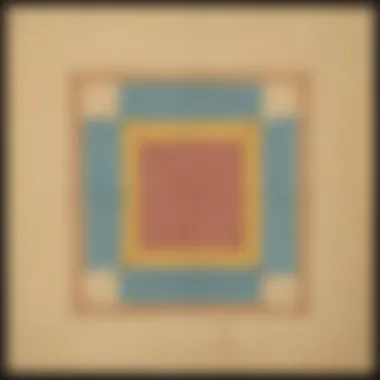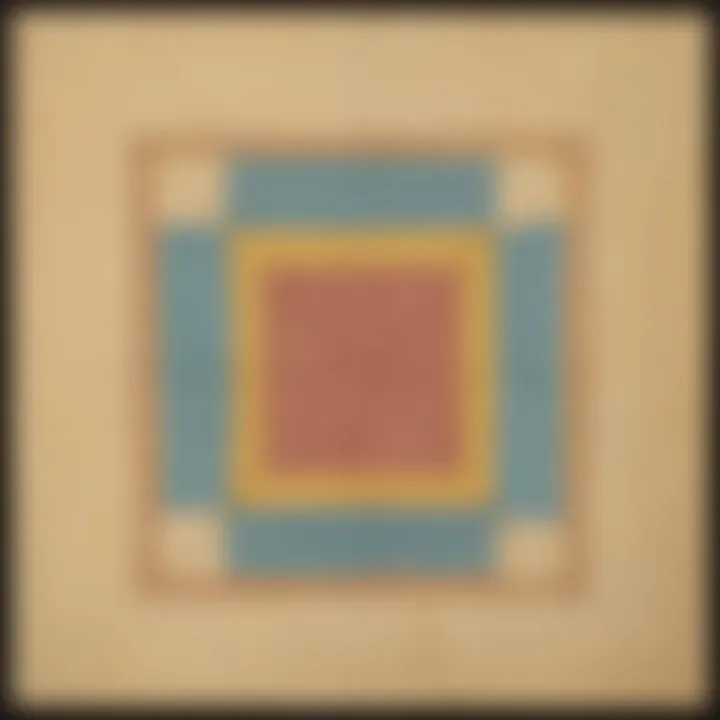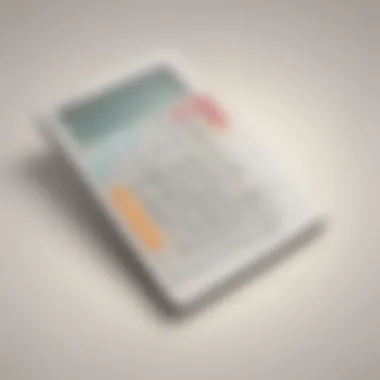Understanding the Diagonal of a Square: Tools and Methods


Intro
Understanding the diagonal of a square is a key concept in geometry. It involves not only basic formulas but also creative tools that can help young learners grasp these ideas more effectively. This section outlines engaging ways children can explore the diagonal length of squares and the essential methods employed in this study.
The diagonal of a square connects two opposite corners. It represents the shortest distance between those corners that is not along the edges. Calculating the length of the diagonal can also be a fun exercise. The classic formula derived from the Pythagorean theorem gives us a simple way to find this length: Diagonal = side length × √2. By exploring this formula, students can develop solid mathematical foundations and improve their analytical skills.
Using various tools and methods can considerably enhance understanding. Diagonal calculators, for example, provide immediate results for those who want quick answers. At the same time, hands-on activities can reinforce these concepts in a memorable way. Through creative projects and fun quizzes, comprehension of this geometric idea can be both enjoyable and educational. We will now explore these creative activities in detail.
Prelude to Geometry
Geometry forms the backdrop not just for mathematics but also for everyday life. Understanding this subject allows us to grasp the spatial relationships between various shapes. Such knowledge aids in disciplines like architecture, engineering, and even art. Geometry lays the groundwork for many concepts we engage with routinely, from simple shapes to complex forms. Explaining geometry to younger audiences, such as elementary school children, fosters critical thinking and analytical skills, which are vital for their later academic endeavors.
Definition of Geometry
Geometry is a branch of mathematics that studies the properties and relationships of points, lines, shapes, and spaces. It originated in ancient civilizations to deal with physical dimensions. Basic geometry involves understanding fundamental shapes like circles, triangles, and, of course, squares. Each of these shapes has unique properties and formulas related to area and perimeter, but geometry transcends mere calculations. It also encompasses the visual and spatial awareness that helps connect concepts to the physical world.
Importance of Shapes
Shapes inhabit multiple environments and represent diverse ideas. In geometry, they serve as building blocks for understanding space and architecture. Shapes allow the visualization of mathematical concepts. For children, learning about shapes can enhance creativity and encourage exploration. The ability to differentiate between shapes can help them solve problems and think critically.
- Shapes can be classified as:
- 2D Shapes: such as circles and squares.
- 3D Shapes: such as cubes and spheres.
Grasping the importance of shapes can provide students with the tools they need to succeed academically. Through simple visualizations and concrete examples, children can better understand principles of geometry that will help them in future studies.
Understanding Squares
Understanding squares is a fundamental aspect of geometry. A square is not just another shape; it holds various properties and significance that extend beyond its appearance. In this article, we will explore the importance of squares, their characteristics, and their everyday applications. This knowledge serves as a foundation for diving into the calculation of their diagonals, which is essential for grasping more complex geometric concepts.
Characteristics of a Square
A square is defined by its unique properties. It has four equal sides and four right angles, making it a regular quadrilateral. The important characteistics include:
- Equal Lengths: All sides are the same length.
- Right Angles: Each internal angle measures 90 degrees.
- Symmetry: Squares have both mirror and rotational symmetry.
- Diagonal Properties: The diagonals of a square are equal in length, bisect each other at right angles, and create two congruent triangles.
These characteristics make squares special. Understanding these properties is crucial, as it helps in recognizing the square's role in various geometric calculations, including finding the length of its diagonals.
Square in Everyday Life
Squares are prevalent in daily life, and recognizing their presence can deepen one's understanding of geometry. From tiles on floors to the design of book covers, these shapes appear everywhere. Some common examples include:
- Architecture: Many buildings and windows incorporate square shapes in their designs.
- Technology: Icons and screens often use square pixels for display quality.
- Art and Design: Squares form the basis of many artistic compositions.
Understanding how squares function in everyday scenarios helps children connect mathematical concepts with practical applications. This real-world connection fosters a more profound appreciation for geometry, motivating students to explore further.
Recognizing the importance of squares can lead to a greater understanding of geometry and mathematical application in life.
As we continue to explore the diagonal of a square, it becomes essential to grasp these basic notions of squares, offering a basis for more complex calculations and applications.
The Diagonal of a Square
Definition and Explanation
A diagonal of a square is a line segment that connects two opposite corners. It is important to understand how to find the length of this diagonal. The formula to calculate the diagonal ( d) of a square is derived from the properties of the square itself. If we denote the length of a side of the square as s, the diagonal can be calculated using the formula:
[ d = s \sqrt2 ]


This equation arises from the Pythagorean theorem. When a square is divided into two right triangles, the diagonal serves as the hypotenuse. Knowing this can help students connect concepts of geometry easily.
Importance of Knowing the Diagonal
Understanding how to calculate the diagonal of a square is beneficial for several reasons. First, it enhances spatial reasoning skills, which are crucial in fields like architecture and engineering. Moreover, a diagonal divides a square into two equal parts. This knowledge can support students in solving problems regarding area and volume of three-dimensional shapes.
A clear grasp of diagonals can aid in understanding more complex geometric concepts later.
Benefits of Knowing the Diagonal:
- Enhanced Problem-Solving Skills: Knowing the diagonal helps students approach geometric problems with more confidence.
- Real-Life Applications: Many practical tasks, such as determining the dimensions of a room or a piece of furniture, require diagonal measurements.
- Connections to Other Shapes: Learning about diagonals can lead to better understanding of how different shapes interact within geometry.
Calculating the Diagonal
Calculating the diagonal of a square can seem simple at first. However, it plays a central role in understanding geometry. The diagonal acts as an essential bridge between concepts of area and perimeter. Knowing how to calculate it not only reinforces basic math skills but also provides insight into the relationships between the square's sides. This understanding is particularly beneficial for young learners as they explore mathematical relationships in a tangible way.
Basic Formula for Diagonal
The basic formula for calculating the diagonal of a square is straightforward. It is derived from the Pythagorean theorem. For a square with a side length denoted as s, the diagonal d can be calculated using the equation:
d = s × √
This formula indicates that the diagonal is equal to the side length multiplied by the square root of 2. This specific relationship arises because in a square, the diagonal creates two right-angled triangles. Each of these triangles has equal sides (the square's sides) and the diagonal itself is the hypotenuse. Knowing this formula enables students to compute the diagonal with ease when they know the side length.
Deriving the Formula
Deriving the formula for the diagonal involves the application of the Pythagorean theorem. Let's break down the derivation step by step:
- Identify the right triangle: When you draw a diagonal, it splits the square into two equal right triangles. Each triangle has two legs of length s (the sides of the square).
- Apply the Pythagorean theorem: According to this theorem, in a right triangle, the square of the hypotenuse (d) is equal to the sum of the squares of the other two sides. This can be expressed as:d² = s² + s²
- Combine the terms: Since both sides are equal, we can rewrite the equation as:d² = 2s²
- Solve for d: To find the length of the diagonal, take the square root of both sides:d = √(2s²), which simplifies to d = s√2.
This step-by-step approach not only provides the formula but also adds depth to a learner’s understanding. By grasping why this formula works, students can better appreciate the interconnectedness of geometric figures.
Important Note: Understanding how to calculate and derive the diagonal empowers learners with essential geometric skills. This knowledge is a foundational element in further studies of geometry, architecture, and design.
Using the Diagonal Calculator
Understanding how to utilize a diagonal calculator can significantly enhance the learning experience for students exploring geometry. Diagonal calculators provide quick solutions for finding the length of the diagonal in a square. This is particularly beneficial for elementary school children who may still be grappling with basic math concepts. By streamlining the process, these tools simplify complex calculations and allow learners to focus more on comprehension rather than mere computation.
Preamble to Diagonal Calculators
Diagonal calculators are digital tools designed to assist in calculating the diagonal lengths of squares easily and efficiently. These tools often feature user-friendly interfaces where students can input the length of one side of the square. Once the input is made, the calculator performs the necessary calculations and displays the result instantly. This immediate feedback is crucial for reinforcing learning and ensuring that students understand the relationship between the length of the sides and the diagonal.
Additionally, the usage of calculators encourages students to be more engaged with geometry. They feel empowered to explore various problems and scenarios without the intimidation of lengthy calculations. This builds confidence in their mathematical abilities.
Step-by-Step Guide to Using the Calculator
Using a diagonal calculator is a simple process. Here’s a guide to help students navigate this tool effectively:
- Identify the Side Length: Start by determining the length of a side of the square. This will be your main input.
- Input the Value: Enter the side length into the calculator. Ensure that the measurement unit is consistent for accuracy.
- Calculate: Most calculators have a 'Calculate' button. Click it to see the diagonal length.
- Interpret the Result: The output will show the length of the diagonal. Discuss what this means in relation to the square's properties.
- Practice with Different Values: Encourage students to try various side lengths to see how the diagonal changes. This variation will bolster their understanding of geometric principles.
This methodical approach fosters analytical thinking, helping students appreciate the interconnectedness of shapes and their properties.
Using diagonal calculators not only simplifies the learning process but also prepares students for more advanced mathematical concepts down the line. By mastering these basic tools, they can develop a solid foundation in geometry.
Applications of Diagonal Calculation
The calculation of a square's diagonal plays a crucial role in various fields. Understanding this concept is not just about mathematics; it is also about seeing how geometry is integrated into everyday life. This section explores the significance of diagonal calculations and their applications in real-world situations and design fields.
Real-World Scenarios


In daily life, the diagonal of a square shows up more often than one might think. For example, in home improvement or construction, knowing the diagonal helps in ensuring that spaces are square. A common tool like a carpenter's square employs the diagonal for checking the right angles. If the diagonal measurement is proportional to the sides, the corners are accurate, improving structural integrity.
Consider a situation such as laying out flooring or tiles. Knowing the diagonal helps arrange tiles more efficiently, reducing waste. Diagonal calculations guide how to optimize materials during construction projects. If accurate, this ensures better resource management and cost-effectiveness.
Another scenario is in planning gardens or landscape design.
Understanding measurements, including diagonals, contributes to precise layouts. This can dramatically enhance aesthetic appeal and functionality.
Importance in Design and Architecture
In the world of design and architecture, the diagonal holds particular importance. It brings balance and proportion to a design. Many architectural designs, especially modern ones, rely on the diagonal to create visual interest and harmony. When an architect approaches a project, they often consider how diagonals can affect both beauty and function.
Using diagonals alters the perception of space. For instance, a room's diagonals affect how spacious it feels. Designs that use diagonal lines or features can lead to innovative structures. They can even create unexpected focal points, engaging viewers and drawing the eye. A well-placed diagonal feature can transform an ordinary space into something extraordinary.
Key points to remember include:
- Diagonals strengthen architectural stability.
- They are essential for creating aesthetically pleasing environments.
- Diagonal measurements assist in ensuring spatial accuracy and effectiveness in design.
In summary, the applications of diagonal calculation in real life and design underscore its relevance in geometry. Both fields benefit from a solid understanding of these concepts, granting students and practitioners tools to enhance their skills and results.
Educational Resources for Learning Geometry
Understanding geometry, particularly the diagonal of a square, can be greatly enhanced through various educational resources. These resources play an important role in clarifying concepts, fostering engagement, and promoting the analytical skills of elementary school children. By exploring different types of materials, students can discover their preferred learning styles while interacting with geometric concepts in diverse ways.
The availability of both traditional and modern resources allows learners to deepen their knowledge effectively. This section highlights the benefits and considerations of utilizing educational resources in geometry.
Books and Online Materials
Books remain a timeless tool in learning geometrical concepts. They provide in-depth explanations, illustrations, and examples. When it comes to understanding the diagonal of a square, books can offer detailed steps for calculations, historical context, and advanced topics that can enhance comprehension.
Online materials complement traditional learning with dynamic content that captures attention. Websites like Wikipedia and Britannica offer comprehensive articles related to geometry, providing factual information that learners can explore at their own pace.
Consider the following benefits of using books and online materials:
- Structured Learning: Books offer a logical flow of information, making complex ideas easier to grasp.
- Accessibility: Online resources are often easily accessible on various devices, allowing learners to study from anywhere.
- Diverse Perspectives: Different authors and websites present unique approaches that can enrich understanding.
However, it is advisable to choose materials that are age-appropriate. Elementary school children may benefit from simplified texts and visuals that align with their learning level.
Interactive Tools and Games
Interactive tools and games provide an engaging approach to learning geometry. These resources offer animated visuals, interactive exercises, and immediate feedback, which can make complex concepts like the diagonal of a square more graspable.
Using platforms like educational apps and websites, children can practice calculating diagonals through enjoyable activities. They can learn the formulas in an entertaining way. Here are some notable advantages of interactive tools:
- Enhanced Engagement: Games capture interest, motivating students to learn without feeling overwhelmed.
- Immediate Feedback: Interactive platforms provide instant evaluations, helping students rectify mistakes on the spot.
- Practical Application: Games often present real-world scenarios that encourage learners to apply theories to practical situations.
Both interactive tools and books serve significant roles in geometry education. Together, they create a comprehensive learning environment that fosters understanding and retention of concepts related to the diagonal of a square.
“The use of varied educational resources can transform the learning experience, enabling students to explore geometry beyond traditional methods.”
Common Mistakes in Diagonal Calculation
Understanding the common mistakes in calculating the diagonal of a square is vital for everyone learning geometry. Missteps can often lead to errors, resulting in incorrect conclusions. Recognizing where misunderstandings occur can help instill confidence in students. A well-rounded grasp of these mistakes prepares learners not just to solve problems correctly but also to understand the underlying concepts behind their calculations.
Misunderstanding the Formula
The diagonal of a square can be found using the formula:
d = s√2
where d represents the diagonal length and s is the side length of the square. Many learners struggle with the square root and the implications of this relationship. Some students might forget to apply the square root or miscalculate its value, leading them to incorrect results.
Furthermore, students may confuse the diagonal with other important measurements such as the perimeter or area. It is crucial to emphasize the formula’s specific variables and their meanings. When students understand each part of the formula, they are more likely to apply it correctly.
Errors in Measurement


Accuracy in measurement is another vital aspect of calculating the diagonal correctly. If the measurement of the square’s sides is incorrect, the diagonal calculation will also be flawed. Students often misread rulers or measurement tools. Over time, they might not realize they have made small errors in their initial inputs.
To avoid these issues, learners should:
- Always double-check measurements before calculation.
- Use clear, standardized tools like a ruler or measuring tape.
- Ensure that they accurately align the tool with the edges of the square when measuring.
By being vigilant about measurement, students can enhance their precision in calculating the diagonal, leading to a greater understanding of geometry as a whole.
Key Takeaway: Understanding common mistakes can guide learners to success in geometry. Focusing on the formula, ensuring accurate measurements, and emphasizing attention to detail will help improve their skills.
Practice Problems
Practice problems are essential in mastering the concept of the diagonal of a square. Engaging with a variety of problems helps learners apply theoretical knowledge to practical situations, thereby reinforcing their understanding. This section focuses on different levels of practice problems that can benefit elementary school children, parents, and caregivers. By working through these problems, students can develop critical analytical skills and a solid foundation in geometry.
Benefits of Practice Problems:
- Reinforcement of Concepts: Solving problems allows students to revisit and solidify their understanding of diagonal calculations and related formulas.
- Development of Problem-Solving Skills: Practice fosters a strategic approach to problem-solving that students can apply to a variety of math topics.
- Preparation for Real-World Applications: Understanding how to calculate the diagonal has practical applications in design, construction, and other fields.
Considerations:
- Ensure problems vary in complexity to challenge learners at different skill levels.
- Provide guidance on how to approach problems and think critically.
Basic Problems for Beginners
Basic problems serve as an introduction to the concept of the diagonal in a square. These problems are designed to build confidence in students who may be new to geometry. Here are a few examples:
- Calculate the Diagonal of a 4 cm Square:
- What is the Diagonal of a 10 cm Square?
- If a square has a diagonal of 14 cm, what is the length of each side?
- Use the formula: Diagonal = side × √2.
- Answer: Diagonal = 4 × √2 = 4√2 cm.
- Apply the same formula.
- Answer: Diagonal = 10 × √2 = 10√2 cm.
- Rearrange the formula: Side = Diagonal / √2.
- Answer: Side = 14 / √2 ≈ 9.9 cm.
These problems reinforce the basic formula for the diagonal and help students gain familiarity with calculations in a straightforward manner.
Advanced Application Problems
Advanced application problems challenge students to think deeper and apply their understanding of diagonal calculations to more complex scenarios. Here are some examples:
- Finding the Diagonal in a Room Layout:
- Impact on Design:
- Comparing Squares:
- A rectangular room measures 12 feet by 16 feet. Calculate the diagonal distance between opposite corners.
- Approach: Use the Pythagorean theorem because it’s a rectangle. Diagonal = √(length² + width²).
- Answer: Diagonal = √(12² + 16²) = √(144 + 256) = √400 = 20 feet.
- If a designer wants to create a square artwork with a diagonal of 30 inches, what will be the length of the sides?
- Approach: Use Side = Diagonal / √2.
- Answer: Side = 30 / √2 ≈ 21.2 inches.
- Given two squares, one with a side of 8 cm and another with a side of 12 cm, calculate their diagonals and determine the difference.
- Answer: Diagonal of first square = 8√2 cm; Diagonal of second square = 12√2 cm. Difference = 12√2 - 8√2 = 4√2 cm.
Engaging in these advanced problems enhances critical thinking. It also encourages learners to apply concepts to real-world situations, showcasing the relevance of geometry in their lives.
Ending
The conclusion is a critical component of this article as it summarizes the main points related to the diagonal of a square. Understanding the diagonal encompasses knowing how to calculate it, its significance in geometric shapes, and its practical applications in our daily lives. Each of these elements is fundamental because they not only bolster a student’s mathematical knowledge but also enhance their ability to think logically and solve problems.
Recap of Key Points
- The diagonal of a square is more than just a line; it represents the connecting path between two opposite corners, demonstrating an important property of squares.
- We derived the formula for the diagonal using the properties of right triangles, showcasing the link between different areas of geometric study.
- Tools such as diagonal calculators are practical in simplifying complex calculations, making geometry more accessible for students.
- Recognizing common mistakes in diagonal calculations helps learners develop better precision in their mathematical approaches.
Encouragement for Further Exploration
Exploring the diagonal of a square sets the groundwork for more advanced mathematical concepts. Students, parents, and caregivers should embrace the idea that understanding basic geometry is a stepping stone to deeper analytical skills. By engaging with the topic further, learners can:
- Investigate other geometric shapes and their properties, enhancing their overall comprehension of space and form.
- Utilize interactive learning resources and games that promote mathematical skills in a fun and engaging manner.
- Discuss the applications of geometry in real-world situations, such as architecture, engineering, and art, making the subject more relatable.
By continuing this exploration, students not only solidify their foundational knowledge but also inspire a sense of curiosity that drives lifelong learning in mathematics.







